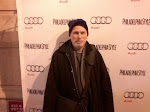Seabiscuit, a racehorse of the ’30s, is today's Wikipedia entry. A few years ago Seabiscuit was the subject of a popular movie and a best-selling book. No one seems to have noticed or cared how National Velvet, which opens the oeuvre of Elizabeth Taylor, echoes the tale of Seabiscuit.
Elizabeth Taylor, born in London in 1932, made her film debut at 10 in 1942; she emerged as a child star in National Velvet (1944). In that movie, Anne Revere won the Oscar for best actress for her portrayal of Velvet Brown’s mother.
As a young woman, Mrs Brown, in an act of folly and glory which reverberated through a lifetime of dependable work and virtue, swam the English Channel. Her daughter Velvet has won a jumping horse in a raffle and wants to enter the National. Opposite Velvet, Mickey Rooney plays a washed-up jockey. He would remind a current viewer of Red Pollard, the rider of Seabiscuit. As in all sports movies, Seabiscuit and Velvet Brown’s horse win!
Rooney, Margaret O’Brien, Shirley Temple and Judy Garland are typical child stars who fail to mature as actresses. But Taylor successfully played an adult in Father of the Bride (1950). Taylor first gains a place in film histories with A Place in the Sun (1951) a movie based on Theodore Dresser’s American Tragedy. This time Anne Revere played Montgomery Clift’s mother, not Taylor’s. Soon thereafter, this wonderful actress and descendant of Paul Revere was blacklisted.
Giant featured Taylor, Rock Hudson and James Dean; it was filmed in Marfa, Texas, a town coincidentally now renowned in the art world as the birthplace of Donald Judd and home for his museum and foundation. With Clift and Dean, Taylor was getting the meaty interesting roles of ‘50s Hollywood. And when she starred in Tennessee Williams’ Cat on a Hot Tin Roof (1958) and won an Oscar for Butterfield 8 (1960), Taylor became a newspaper icon.
Authorities differ about her number of marriages. The Columbia Encyclopedia (Fifth edition; 1993) states she was married nine times. The later Cambridge Biographical Encyclopedia (Second edition; 1998) says she was married only eight times. Both agree she was married twice to Richard Burton. That kind of careless error might reflect the contempt many in the academy feel for Elizabeth Taylor. Perhaps, as John Turturro’s mother once said, Taylor’s the type who’d only ever sleep with her husband, which is why she needed so many. She’s had more husbands than Henry VIII had wives. Is it attention--or affection--deficit disorder?
With Cleopatra (1962) she became enmeshed with Richard Burton and, as Rex Reed might say, a legend. The icon wrecks homes! Who can forget? The New Yorker (9 September 2002), for instance, in a discussion of Puff Daddy and Jennifer Lopez, says: “Few couples since Richard Burton and Elizabeth Taylor have appeared more often in the gossip columns.” In the early Sixties, Dick and Liz set a standard for the inescapable. John Lennon and Yoko Ono set a similar standard when I settled in New York in the early Seventies.
Taylor was rich, beautiful, talented and famous. Andy Warhol painted Portrait of Liz (1963-64), The Men in Her Life (Mike Todd and Eddie Fisher) (1962) and Blue Liz as Cleopatra (1962).
Beauty fades. Parts become rare. Scholars grow careless. Yet Taylor remains iconic. For more than 20 years, beginning in 1983, Kathe Burkhart has painted an appetitive Liz as cartoonish bad-girl transgressor. ( See Art in America ) To Burkhart, the seven or eight--or nine?--husbands were hardly hagiographical. To Burkhart, Liz didn’t just play Katharina the shrew. Liz is the Shrew.

